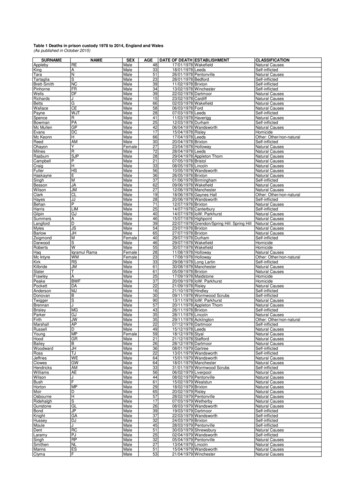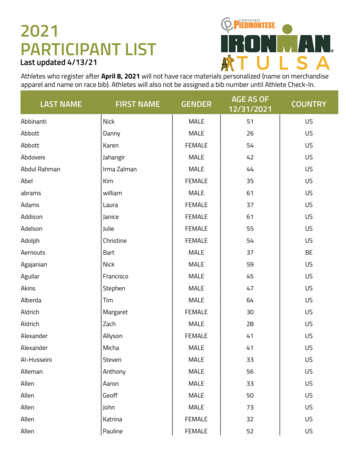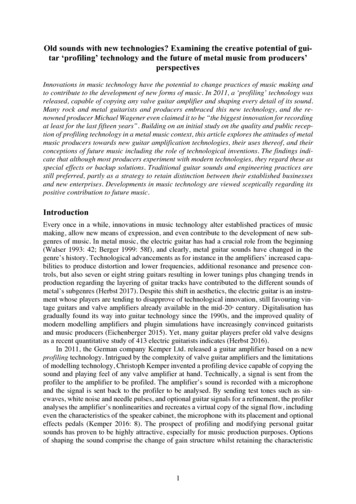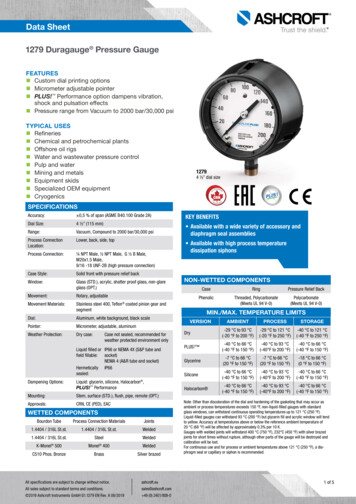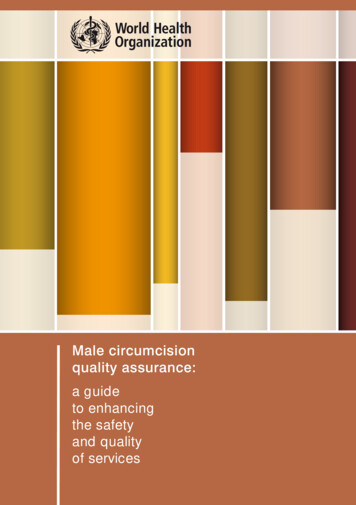
Transcription
Male circumcisionquality assurance:a guideto enhancingthe safetyand qualityof services
WHO Library Cataloguing-in-Publication DataMale circumcision quality assurance: a guide to enhancing the safety and qualityof services.1.Circumcision, Male - standards. 2.HIV infections - prevention and control.3.Quality assurance, Health care. 4.National health programs - standards.5.Practice guideline. I.World Health Organization.ISBN 978 92 4 159731 9(NLM classification: WJ 790) World Health Organization 2008All rights reserved. Publications of the World Health Organization can beobtained from WHO Press, World Health Organization, 20 Avenue Appia, 1211Geneva 27, Switzerland (tel.: 41 22 791 3264; fax: 41 22 791 4857; e-mail:bookorders@who.int). Requests for permission to reproduce or translate WHOpublications – whether for sale or for noncommercial distribution – should beaddressed to WHO Press, at the above address (fax: 41 22 791 4806; e-mail:permissions@who.int).The designations employed and the presentation of the material in thispublication do not imply the expression of any opinion whatsoever on the part ofthe World Health Organization concerning the legal status of any country,territory, city or area or of its authorities, or concerning the delimitation of itsfrontiers or boundaries. Dotted lines on maps represent approximate borderlines for which there may not yet be full agreement.The mention of specific companies or of certain manufacturers’ products doesnot imply that they are endorsed or recommended by the World HealthOrganization in preference to others of a similar nature that are not mentioned.Errors and omissions excepted, the names of proprietary products aredistinguished by initial capital letters.All reasonable precautions have been taken by the World Health Organization toverify the information contained in this publication. However, the published material is being distributed without warranty of any kind, either expressed or implied. The responsibility for the interpretation and use of the material lies with thereader. In no event shall the World Health Organization be liable for damagesarising from its use.Printed in Switzerland
Male circumcisionquality assurance:a guide to enhancingthe safety and qualityof services
ContentsAcronyms. 4Acknowledgements. 5Preface. 7Purpose. . 9Section 1Guidance for national and district programme managers. 13National and district government roles and responsibilities. 14Strategic planning. 15Establishing a planning committee. 15Establishing aim, objectives and guiding principles. 17Policy development. . 19Development of clinical practice guidelines. 19Adopting male circumcision standards. 20Minimum package for male circumcision services. 22Selecting facilities. 23Monitoring and evaluating the programme. 23Setting national and district indicators. 24Supportive supervision. 24Accreditation. 25Competence of providers of male circumcision.27Level of health-care provider.27Essential competences for male circumcision providers. 28Competence-based training. 34Competence assessment. 34Provider certification. . 35Assessing ongoing competence of providers. 38Annex A:Examples of quality assessment and improvement programmes. 39Annex B:Recommended male circumcision standards and criteria. . 442
Table of ContentsSection 2Guidance for facility managers and staff. 53Forming quality improvement teams. 54Quality improvement collaboratives. 55Steps for improving quality. 56Step 1. Define desired performance. . 58Step 2. Assess performance. 58Self-assessment. . 58Peer assessment. 59Step 3. Find causes of performance gaps.61Step 4. Select and implement interventions to improve quality. . 63Step 5. Monitor and evaluate performance. . 64Setting facility-level indicators. 64Supportive supervision. 66Advantages and disadvantages of quality approaches. 663M a le Circumcision Qua lit y A ssur a nce:A Guide to Enh a ncing the Sa fe t y a nd Qua lit y of Serv ice s
Acronyms4AIDSacquired immunodeficiency syndromeHIVhuman immunodeficiency virusUSAIDUnited States Agency for International DevelopmentUNAIDSJoint United Nations Programme on HIV/AIDSWHOWorld Health Organization
AcknowledgementsWHO would like to thank the following people: Joanne Ashton (Consultant, Joint Commission International) and KimDickson (Medical Officer) for producing this document. Tim Farley and Julie Samuelson for contributing to the writing andreview of the Guide. The following members of the WHO/UNAIDS Male CircumcisionWorking Group, who provided input and guidance: Bruce Dick, CateHankins, George Schmid and Isabelle de Zoysa. Special thanks go to the international experts who participated in theQuality Assurance Guidance Review Meeting in December 2007 for theirinsights, contributions and technical review of this document: DavidAlnwick (UNICEF Eastern and Southern Africa Regional Office, Kenya),Melanie C. Bacon (NIAID/DAIDS/BSP/Epidemiology Branch, NIH, USA),David Benton (International Council of Nurses, Switzerland), Naomi Bock(HIV Prevention, Global AIDS Program, CDC, USA), Peter Cherutich(National HIV/AIDS and STD Control Programme, Ministry of Health,Kenya), Adam Groeneveld (Mbabane Government Hospital, Swaziland),Tim Hargreave (Murrayfield Hospital, Scotland); Francis Hyera (Consultant,South Africa), Peter Johnson (JHPIEGO, USA), Didier M. Kangudie(IntraHealth International, Namibia), Harrison Kiambati (Ministry of Health,Kenya), Samuel Magagula (Ministry of Health, Swaziland), PalesaMohaleroe (M&H Mediclinic, Lesotho), Jeckoniah O. Ndinya-Achola(Department of Medical Microbiology, University of Nairobi, Kenya),Edgar Necochea (JHPIEGO, USA), Paul van Ostenberg (Joint CommissionInternational, USA), Kwaku Yeboah (Family Health International, USA),and WHO staff members V. Chandra-Mouli, Meena Cherian, KirstyMcHarry and Kenji Tamura.5M a le Circumcision Qua lit y A ssur a nce:A Guide to Enh a ncing the Sa fe t y a nd Qua lit y of Serv ice s
PrefaceIt was estimated in 2007 that 33 million people were living with the human immunodeficiency virus (HIV) and that 2.7 million became newlyinfected with the virus by the end of that year.1 Discovering ways to prevent transmission of the virus is of primary concern to health care authorities worldwide. Auspiciously, male circumcision has been identifiedas a means of decreasing the transmission of HIV infection. In 2005 theSouth Africa Orange Farm Intervention Trial demonstrated a reduction ofat least 60% in HIV infection among men who were circumcised. 2 Twotrials in Kenya and Uganda were discontinued in December 2006 because of clear findings that circumcision reduced HIV transmission. 3 4 Asa result, WHO and UNAIDS convened an international consultation inMarch 2007 to review the results of these trials, discuss the policy andprogramme implications, and make public health recommendations.Eleven recommendations were made, among them the following. Countries should ensure that male circumcision is provided with fulladherence to medical ethics and human rights principles. Informedconsent, confidentiality and absence of coercion should be assured. Countries considering the introduction or expansion of male circumcision services for HIV prevention should ensure that appropriate laws,regulations and policies are developed so that male circumcision services are accessible and provided safely and without discrimination. Male circumcision should not be delivered in isolation but as partof a recommended minimum package which includes informationabout the risks and benefits of the procedure, counselling aboutthe need to adopt and maintain safer sexual practices, access toHIV counselling and testing, condom promotion and provision,and the management of sexually transmitted infections. Careful monitoring and evaluation of male circumcision service delivery should include consideration of possible untoward effectssuch as increases in unsafe sex and increases in sexual violence,and should be undertaken to ensure that programmes promotingmale circumcision for HIV prevention meet their desired objectives.7M a le Circumcision Qua lit y A ssur a nce:A Guide to Enh a ncing the Sa fe t y a nd Qua lit y of Serv ice s
Training and certification of providers should be rapidly implemented to increase the safety and quality of services in the publicand private sectors. Supervision systems for quality assurance should be establishedalong with referral systems for the management of adverse eventsand complications.5Male circumcision can be a relatively simple and safe procedure. However; studies have shown that serious adverse events can occur whencircumcisions are poorly managed.6 Shortages of instruments, suppliesand well-trained staff dramatically affect the outcomes of these procedures.7 8 9 10 Consequently, WHO is working with countries to providetechnical guidance supporting the implementation of safe and effectivemale circumcision services.11 Key strategies for providing safe procedures and minimizing the risks of complications involve developing andimplementing standards, ensuring provider competence, and monitoringand improving the quality and safety of care.8
PurposeThis Guide has been developed to assist national and district programmeand health facility managers and providers to establish and implementmale circumcision services that meet an internationally agreed level ofsafety and quality.It provides programme managers with information aimed at helping themto fulfil their roles and responsibilities in organizing male circumcisionservices that are safe and effective. It can be used to support the establishment of services in various circumstances, e.g. health centres, hospitals, mobile units, temporary sites or when a centre of excellence isbeing created.The Guide is complemented by the Male Circumcision Services QualityAssessment Tool Kit, a practical set of tools for assisting facility managers and providers to assess their own performance and the quality ofcare provided and to define gaps that exist in the provision of male circumcision services. The tools also can be used by national and districtmanagers to conduct external assessments of facilities.Structure of the GuideThis Guide is divided into two sections.Section 1 outlines the roles and responsibilities of national and districtprogramme managers for implementing safe male circumcision servicesof good quality and provides guidance for the planning of a national quality assurance programme. Ten standards are outlined that define the requirements to be met by all facilities providing male circumcision services.These standards should be reviewed and adapted or adopted at nationallevel. Statements of intent explain the purposes of the standards and provide guidance on adapting them as required. A recommended minimumpackage of services is defined to emphasize that male circumcision forHIV prevention should not be focused on the surgical procedure alone.Broad guidelines for the monitoring and eva
PurPose This Guide has been developed to assist national and district programme and health facility managers and providers to establish and implement male circumcision services that meet an internationally agreed level of safety and quality. It provides programme managers with information aimed at
